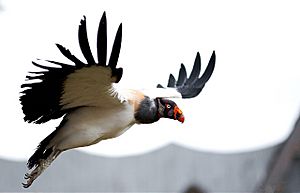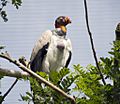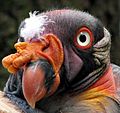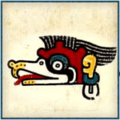King vulture facts for kids
Quick facts for kids King vulture |
|
|---|---|
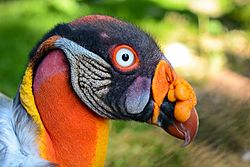 |
|
| The extraordinary head of the king vulture | |
| Conservation status | |
| Scientific classification | |
| Kingdom: | |
| Phylum: | |
| Class: | |
| Order: | |
| Family: | |
| Genus: |
Sarcoramphus
|
| Binomial name | |
| Sarcoramphus papa (Linnaeus, 1758)
|
|
The king vulture (Sarcoramphus papa) is a large bird found in Central and South America. It belongs to the New World vulture family. This vulture mostly lives in warm, wet forests from southern Mexico to northern Argentina. It is the only living bird in its group, called Sarcoramphus.
King vultures are large and mostly white. They have gray to black feathers around their neck, on their wings, and on their tail. Their head and neck have no feathers. The skin on their head and neck can be yellow, orange, blue, purple, or red. The king vulture has a very noticeable orange fleshy bump on its beak. This vulture is a scavenger, meaning it eats dead animals. It often makes the first cut into a fresh carcass. It can also push away smaller New World vultures from a meal. King vultures have lived for up to 30 years in zoos.
King vultures were important symbols in ancient Mayan books and in local stories and medicine. Even though they are currently listed as least concern by the IUCN, their numbers are going down. This is mainly because their habitat is being lost.
Contents
What Does a King Vulture Look Like?
The king vulture is the largest New World vulture, except for the two condor species. It can be about 67 to 81 centimeters (26 to 32 inches) long. Its wings can spread from 1.2 to 2 meters (4 to 6.5 feet) wide. It weighs between 2.7 and 4.5 kilograms (6 to 10 pounds).
Adult king vultures are mostly white with a slight rose-yellow color. Their wing feathers and tail are dark gray to black. They also have a thick, dark neck ruff. Their head and neck have no feathers. The skin on their head is shades of red and purple. Their neck is bright orange, and their throat is yellow.
The skin on their head is wrinkled. They have a very noticeable golden crest above their orange and black beak. This crest fully forms when the bird is about four years old.
The king vulture has the largest skull and brain for its size among New World vultures. It also has the strongest beak. Its beak has a hooked tip and a sharp cutting edge. The bird has wide wings and a short, wide, square tail.
The center part of its eyes (the irises) are white with bright red borders. Unlike some other vultures, the king vulture does not have eyelashes. It has gray legs and long, thick claws.
The vulture's head and neck are featherless. This helps them stay clean. When they eat dead animals, this lack of feathers stops bacteria from getting stuck. It also lets the sun's rays clean their skin.
King vultures live in an area of about 14 million square kilometers (5.4 million square miles). This area stretches from southern Mexico to northern Argentina. They mostly live in untouched tropical lowland forests. They can also be found in savannas and grasslands that are close to these forests. They are often seen near swamps or wet areas in the forests.
King Vulture Behavior
The king vulture can soar for hours without much effort. It only flaps its wings sometimes. Its wing beats are deep and strong. Even though it is large and colorful, this vulture is hard to spot when it sits in trees. When perched, it holds its head low and forward.
It usually lives alone or in small family groups. Sometimes, groups of up to 12 birds have been seen bathing and drinking together. Usually, one or two birds will come down to eat at a dead animal. However, if there is a lot of food, up to ten or more may gather.
King vultures have lived up to 30 years in zoos. How long they live in the wild is not known. Even with its strong beak and large size, it is not very aggressive when feeding. The king vulture does not have a voice box. It can make low croaking noises and wheezing sounds when trying to find a mate. When it feels threatened, it makes bill-snapping noises.
Its only natural enemies are snakes, which eat the vulture's eggs and young. Large cats like jaguars might surprise and kill an adult vulture at a dead animal.
The king vulture eats many different things. This includes dead cattle, fish washed ashore, and dead lizards. It mainly eats dead animals. There are a few reports of it killing and eating injured animals, newborn calves, and small lizards. The vulture’s tongue is rough, like a rasp. This helps it pull meat off bones. Generally, it only eats the skin and tougher parts of the meat. King vultures have also been seen eating fallen fruit from the moriche palm tree when there isn't enough dead meat.
King Vultures and People
The king vulture is one of the most common birds shown in ancient Mayan books. Sometimes, the bird is shown as a god with a human body and a bird head. According to Mayan stories, this god often carried messages between people and the other gods. The bird's blood and feathers were also used to help cure illnesses.
The king vulture is also a popular bird on postage stamps in the countries where it lives. It appeared on a stamp for El Salvador in 1963, Belize in 1978, Guatemala in 1979, Honduras in 1997, Bolivia in 1998, and Nicaragua in 1999.
Because of its large size and beauty, the king vulture is a popular attraction at zoos around the world.
Images for kids
-
London Zoo, 2006
-
Egg exhibited at Brevard Zoo
-
Adult at the Berlin Zoo
See also
 In Spanish: Cóndor de la selva para niños
In Spanish: Cóndor de la selva para niños







